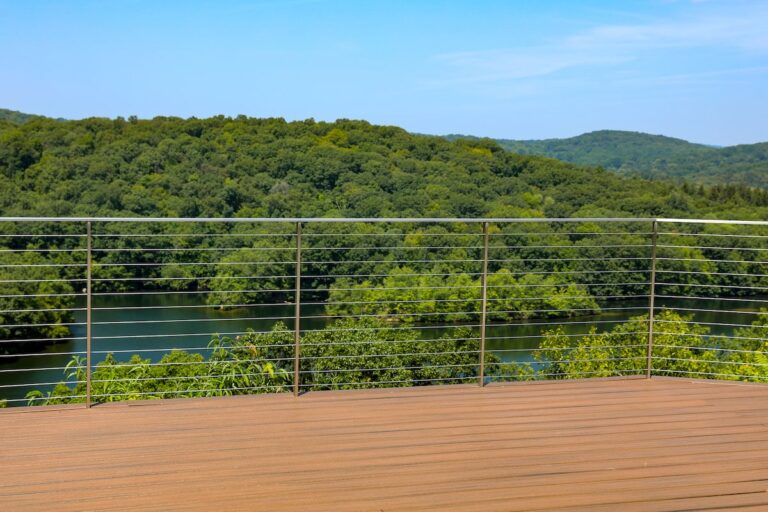You are using an outdated browser. Please upgrade your browser to improve your experience.
Achieve a Modern Look with High-End Quality Cable Railing
Stainless steel cable rails keep you safe while maintaining a modern and stylish appearance. Designed to be visually unobtrusive, they can blend seamlessly into any space.
Cable railing uses horizontal or vertical cables as the main infill instead of traditional materials like wrought iron, wood, or glass. They’re typically used for decks, balconies, stairways, and walkways.
Our custom cable railings are made from marine-grade 316 stainless steel, prized for its excellent corrosion resistance, strength, and longevity. They can be finished with a wooden top rail to create a distinctive look that complements the surrounding decor.
High quality and durable, our stainless steel cable rails are a reliable, low-maintenance choice for both residential and commercial properties.
The Benefits of Stainless Steel Cable Railing
Cable railings provide a number of distinct advantages for homeowners, such as:
- Unobstructed Views: Cable railings maximize visibility and allow for breathtaking views, making them ideal for balconies and properties with scenic surroundings.
- Modern Aesthetics: Cable railings create a sleek and contemporary look that complements various architectural styles and adds a touch of sophistication to any space.
- Durability and Longevity: Fashioned from high-quality stainless steel, cable railings are incredibly durable. They can withstand harsh weather conditions, ensuring years of use with little need for maintenance.
- Safety: Cable railings provide a secure barrier that can meet all relevant building codes and safety standards while maintaining an open feel on your property.
- Increased Natural Light: The open design of cable railings allows for increased natural light flow, creating a brighter and more inviting atmosphere.
Design Options for Cable Railing
Cable diameter and spacing can vary, influencing the overall look and feel of the railing. Thinner cables offer a more minimalist look, while thicker cables create a more substantial presence. The thickness and distance between cables impacts both aesthetics and safety. Closer spacing provides a more solid barrier when safety is the top priority, while wider spacing helps to enhance the view. Cables can be arranged horizontally, vertically, or even diagonally for a unique look.
While all-metal cable railings are more common, the posts that connect them can be made from other materials as well, such as wood or composite. Wood or painted composite posts can help the railings blend more seamlessly into the overall decor of a wooden deck or otherwise more rustic space.
FAQs about Cable Railings
How Safe Is Cable Railing?
While they seem thin at a distance, stainless steel cables are extremely strong and can withstand significant tension. This makes them effective at preventing falls and providing a secure barrier. Their resistance to rust and corrosion enhances their long-term durability in outdoor environments, contributing to the overall safety of the railing over time.
Furthermore, the largely unobstructed views cable railings provide can actually enhance safety in some situations, such as on balconies or decks, where it’s important to see what’s on the other side.
Local building codes typically require cables to be spaced closely enough to prevent a 4-inch sphere from passing through: this is a standard safety measure to prevent small children from squeezing through the cables. Cables can also be installed vertically to prevent climbing.
Garon Fence has over 44 years of experience meeting code requirements for communities throughout Connecticut, New York, and New Jersey. Our expertly installed railings are very safe and can be customized to meet your particular safety needs.
How Long Do Cable Railings Last?
Stainless steel cable railings can last for decades. The most important maintenance requirement is to have them periodically inspected to ensure their tensile strength. Otherwise, they’re largely corrosion resistant and easy to clean.
Can Cable Railing Be Used on Stairs?
While more commonly used on decks and balconies, cable railings can absolutely be used on stairs. Cable railings for staircases typically need to be able to withstand greater loads than standard deck railings, so the system needs to be designed and installed with additional strength and support in mind. They also must have a continuous handrail on at least one side of the staircase, sometimes both.
Do Cable Railings Meet Code?
Cable railings are safe and code compliant, as long as they’re installed properly and regularly maintained. Even more so than for other home improvements, it’s crucial to hire trained professionals to make sure that your cable railings comply with size and strength requirements and can withstand specified loads.
Free On-Site Consultation in Connecticut, New York, and New Jersey
Based out of Westchester County, NY, Garon Fence serves Connecticut, New York, New Jersey, and the greater New England area. Call 914-666-5596 or contact us online to visit our factory showroom in Bedford Hills or arrange a free, on-site consultation.










